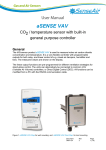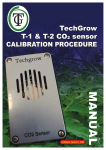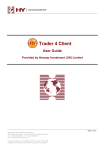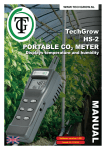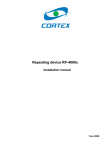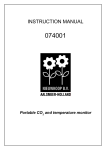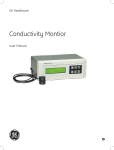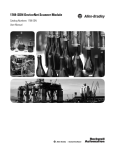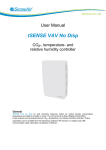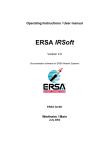Download FUNCTIONAL TEST aSENSE VAV
Transcript
Gas and Air Sensors User Manual aSENSE VAV CO2 / temperature sensor with built-in general purpose controller General The IAQ-sensor product aSENSE VAV is used to measure indoor air carbon dioxide concentration and temperature. It is a very flexible controller with programmable outputs for both relay- and linear control of e.g. mixed air dampers, humidifier and fans. The measured values are shown on the display. The linear output functions are pre-programmed for different ventilation strategies for stand-alone control. The units can alternatively be connected to common VAV (Variable Air Volume) controllers, or Direct Digital Control (DDC). All functions can be modified from a PC with the RS232 communication cable. Figure 1 aSENSE VAV Document Rev Page 1 (18) FUNCTIONAL DESCRIPTION**** This part describes the function of the standard configuration of aSENSE VAV. Please note that the four outputs may completely or partly have other functions. These functions may be programmed before or after the installation. To be sure that every unit is correctly programmed, in accordance to the actual application, a check by a PC and the standard UIP software (version 4.3 or higher) is necessary. Out(1), Out(2) and Out(3) are pre-programmed alternative outputs for demand controlled ventilation. Out(4) is intended for connection to a heat activator, if requested. Out(1) = control signal of demand of coolness and air quality (with reduced flow by extreme cold) Out(2) = control signal of demand of air quality Out(3) = ON/OFF of demand of air quality Out(4) = control signal of heat demand Set point values of temperature (air cooling and heating) and air quality (CO2) can be adjusted individually by the unit’s maintenance push buttons. The different functions with associated outputs are seen in figures 2-7. When a set point value is changed the control curves of that parameter are parallel displaced! Out(1) controls both air quality and temperature but temperature overrules so if the temperature sinks below the LIMIT value the air supply is cut down. Two different gain alternatives can be used in the temperature/cooling feed-back loop. In alternative 1 the P-band is 1 degree and in alternative 2 the P-band is 2 degrees (see figure 2). Temperature compensation of the demand control is done for temperatures below LIMIT value (see figure 4). The standard configuration of aSENSE VAV, with its settings, is typical in many Variable Air Volume (VAV) applications. Even other control parameters can be programmed from the UIP software. There are a number of different regulator blocks available: 6 programmable P-bands (linear functions) with associated set points, 2 additional general purpose P-bands, plus 1 timer function regulator controlled by the DI1terminal are available. In addition, the different regulator outputs may be mixed together using 3 multiplexer (4:1) blocks. To each of the 4 outputs 4 of the available functions can be addressed so that the sum, or the largest value, is transformed to an output signal. The Out(1) and Out(2) outputs can be limited within defined MIN and MAX values. These MIN and MAX values can be set/updated from the push button menu under operation. *** Functional description in detailed block diagram form, installation manuals etc, are available on the Internet! Document Rev Page 2 (18) Figure 2 The control signal of the cooling demand with set point Figure 3 The control signal of the air demand with set point Figure 4 The control signal of the temperature compensation with LIMIT = set point –5 oC Figure 5 The control signal of heating demand with –3 oC dead zone to the set point Figure 6 The control signal of forced ventilation with delay timer Document Rev Page 3 (18) Figure 7 The control signal of air demand with set point Terminal Standard Standard settings* configuration Standard function Out(1) 0-10VDC 600-900 ppm CO2 o 23-24 C o Cut off 18-17 C Air control alt 1 Out(2) 0-10VDC 600-900 ppm CO2 Air control alt 2 Relay Closed Open >600 ppm CO2 < 500 ppm CO2 Air control alt 3 Out(4) 0-10 VDC 20-18 C o Configuration of this sensor Settings of this sensor Heat control Table I. Default configuration of aSENSE VAV. Function description in details with all parameter settings is in a separate document. Formulas for calculation of output values Configuration Output Range Formula for calculation 0-10 VDC 0-2000 ppm CO2 CO2 value = Volt/10*2000 o 2-10 VDC Temperature value in C = Volt/10*50 0-2000 ppm CO2 CO2 value = (Volt –2)/8*2000 o 4-20 mA o 0-50 C Temperature value in C = (Volt –2)/8*50 0-2000 ppm CO2 CO2 value = (mA-4)*2000/16 o 0-50 C a-b o 0-50 C o Temperature value in C = (mA-4)*50/16 c–d Value = (reading-a)/(b-a)*(d-c)+c a = lowest value of the configuration b = highest value of the configuration c = lowest value of the range d = highest value of the range Table II. Calculation of CO2 value and temperature value for aSENSE VAV Document Rev Page 4 (18) Output Configurations A label on the inner side of the sensor lid shows the configuration of the outputs at the time of product delivery. A label at the inner side of the top part shows the terminals and jumpers. The sensors/controllers are supplied from the factory (unless otherwise ordered) with 0...10VDC linear outputs for Out(1), 2 & 4 (see Table II). If different output configurations are needed for the application, these have to be reconfigured before the unit is powered up. Each jumper selection is independent from the others. Default values are 0-10 V and 0-20 mA. Alternative measuring ranges and other start point can be selected in the PC software. Jumper Jumper for selection of P-band cool range Position Function o alt1 Jumper top position provides 1 C as P-band cool range alt2 Jumper bottom position provides 2 C as P-band cool range. o Current Connection in position “Current” provides 0/4-20mA output range for Out(1). Voltage Connection in position “Voltage” provides 0/2-10VDC output range for Out(1) Current Connection in position “Current” provides 0/4-20mA output range for Out(2). Voltage Connection in position “Voltage” provides 0/2-10VDC output range for Out(2). Voltage Connection in position “Voltage” provides 0-10VDC for Out(4). Out(1) Out(2) Out(4) Open Connection in position “Open collector” provides an open collector output. collector Max 0,5A, 55VDC / 40VAC (half-wave rectifier). Table II. Configuration jumpers for aSENSE VAV Document Rev Page 5 (18) Push Button Operation for aSENSE VAV This sensor has two push buttons, MENU and ESC, located on the front panel behind the flip-down lid. The YELLOW LED will acknowledge a successful push by a short flash. Wait until the LED is turned off before next push. The push button MENU is available for selection of display value or maintenance commands, whereas ESC is available to escape back from a selected level. Figure 8 The sensor with push buttons Figure 9 The push button MENU is pushed Figure 10 The push button MENU is pushed Figure 11 The ENTER command is done by pushing buttons MENU and ESC at the same time for about 14 seconds Display modes In DISPLAY MODE the DEFAULT operation is that the sensor alternates between temperature and carbon dioxide readings presentation. The push button MENU(+) is used to select the indicated value on the display to be the error code or the set points Document Rev Page 6 (18) of temperature and CO2. The display will always return to the Default display mode after power up. If a permanent change of default values is requested the PC software is to be used. Function Line Display Time limit Function description 0 Temperature / CO2 no DEFAULT - Normal operation 1 Exxx yes Error code. If no error has been detected the code E0 is shown. The error code is reset with Entr(+-). 2 Present temperature and CO2. set points no Toggle between display of temperature and CO2 set point with MENU(+). Table III. On the display without entering the maintenance menu Maintenance level A number of execution options are available from the MAINTENANCE MENU (see Table IV). This level is accessed only from the display mode in the set points of temperature and CO2 selection. A two buttons push and an access code restrict access, intended for competent trained service personnel only. The Entr(+-) command is done by PUSHING MENU AND ESC AT THE SAME TIME (hold down for about 15 seconds). The access code has eight binary digits; one press at MENU(+) equals 1 and one press at ESC(-) equals 0. The code value can be changed for your personal choise from the software UIP 4.0. The menu diagram in detail is shown in the appendix. Always use the ESC button to return to the DEFAULT mode. Several pushes of the ESC button may be needed to return to the DEFAULT mode. The Entr(+-) push (MENU & ESC) eventually leads to execution of functions, which causes temporary or permanently change of any parameter, that affects the system outputs! Function Line Display Time limit Function description 3 ECxx yes Access code to the service menu The default value of the code is 255 (=11111111, that is eight presses on MENU(+)). Press down MENU(+) and let it scroll until it stops. The last two digits of the code are shown. Then ENTER to accept the selected code. 4a SPt yes For setting the temperature set point. 4b The present temperature set point yes For increase / decrease of the temperature set point. The set point is increased by stepping with MENU(+) button. Decreasing is done by stepping with the ESC(-) button. Document Rev Page 7 (18) 5a SPc yes For setting the set point of the CO2 concentration 5b The present CO2 set point yes 6a AOUt yes For increase / decrease of the CO2-concentration set point The set point is increased by stepping with MENU(+) button. Decreasing is done by stepping with the ESC(-) button. . First step of adjusting the analogue outputs MAX and MIN values 6b An xx no Select analogue output by stepping with MENU(+) button 6c1 SetL no Leads to adjustment of the MIN value. 6d1 The present MIN value in % of FS no Increase the MIN value by stepping with the MENU(+) button. Decrease by stepping with the ESC(-) button. The output is set to the MIN value and can be checked with a multimeter. 6e1 Sure no The adjustment is saved by pressing Entr(+-). Press ESC to return without saving. 6c2 SetH no Leads to adjustment of the MAX value 6d2 The present MAX value in % of FS no Increase MAX value by stepping with the MENU(+) button. Decrease by stepping with the ESC(-) button. The output is set to the MAX value and can be checked with a multimeter. 6e2 Sure no The adjustment is saved by pressing Entr(+-). Press ESC to return without saving. 7 CALb yes 7a Sure yes Background calibration = CO2-sensor calibration with fresh air. An easy way to correct the zero point error. The sensor needs fresh air (380-420 ppm CO2). The calibration must be confirmed by pressing Entr(+-). Confirm that a background calibration shall be done. 8 CAL yes Zero point calibration of the CO2 sensor. The sensor needs zero gas. See the zero point calibration instruction. The calibration must be confirmed by pressing Entr(+-). 8a Sure yes Confirm that a zero point calibration shall be done. Table IV. Maintenance functions available on aSENSE VAV to set output limits. Time limit refers to an internal time-out that returns the LCD and maintenance function back to normal. ENTER is a simultaneous pressing on MENU and ESC. PLEASE NOTE! If a power failure happens when the sensor has Out(1)...4 locked to min/max limits, then the sensor will have this output locked when the power returns. It is necessary to enter this menu item and release the output manually! Document Rev Page 8 (18) EXAMPLE I: Setting of the MAX value of the analogue outputs The access code is time limited. If the time limit is exceeded the sensor returns to DEFAULT. ENTR =MENU(+) and ESC(-) are pushed simultaneously. 1. At the start of the setting the sensor is in DEFAULT. 2. Push MENU(+) once to reach the error code. The display shows E + the error code number. No error is shown as E000. 3. Push MENU(+) once. The display shows the temperature set point e.g. 20. 4. Push ENTR(+-) once. The display shows EC and two digits. Enter the access code to the service menu. If the default code is used do like this: Push MENU(+) until the digits stop. The display shows EC55. If the correct code is not entered before the time limit exceeds the sensor returns to DEFAULT. 5. Push ENTR(+-) once. The display shows SP t to set the temperature set point. 6. Push MENU(+) once to reach the carbon dioxide set point. The display shows SP C. 7. Push MENU(+) once to reach the setting of analogue outputs. The display shows AOUt. 8. Push ENTR(+-) to reach the output to be set. The display shows An and two digits e.g. An 01. Step to the requested output by pushing MENU(+). 9. Push ENTR(+-) to reach the setting of the MIN value. The display shows Set L. 10. Push MENU(+) to reach the setting of the MAX value. The display shows Set H. 11. Push ENTR(+-) to set the MAX value of the output. The display shows the numerical value in % e.g. the standard setting100.0 % or previously set value. Push MENU(+) to increase the MAX value. Push ESC(-) to decrease the MAX value. Push ENTR(+-). The display shows Sure. Push ENTR(+-) to save the setting and return to Set H. Push MENU(+) or ESC(-) to return to Set H without saving the new setting. Push ESC(-) to return to the output to be set, item 12. Push ESC(-) once again to return to the setting of analogue outputs item 11. Document Rev Page 9 (18) Figure 12 Maintenance functions available on aSENSE VAV to set output limits. Only flow shart for setting High limits are shown, but Low limits are set in the very same way. Function blocks that are time limited are indicated by blue boarders. Time limit refers to an internal time-out that returns the LCD and maintenance function back to normal. ENTER is a simultaneous pressing on MENU and ESC. Document Rev Page 10 (18) EXAMPLE II: Setting of temperature set point The access code and the recalibration of the sensor are time limited. If the time limit is exceeded the sensor returns to DEFAULT. ENTR =MENU(+) and ESC(-) are pushed simultaneously. 1. At the start of the setting the sensor is in DEFAULT. 2. Push MENU(+) once to reach the error code. The display shows E + the error code number. No error is shown as E000. 3. Push MENU(+) once. The display shows the temperature set point e.g. 20. 4. Push ENTR(+-) once. The display shows EC and two digits. Enter the access code to the service menu. If the default code is used do like this: Push MENU(+) until the digits stop. The display shows EC55. If the correct code is not entered before the time limit exceeds the sensor returns to DEFAULT. 5. Push ENTR(+-) once. The display shows SP t to set the temperature set point. 6. Push ENTR(+-) once. The display shows the temperature set point e.g. 20.0 oC. Push MENU(+) to increase the set point value in steps of 0.2oC. Push ESC(-) to decrease the set point value in steps of 0.2oC. 7. Leave the unit, which returns to DEFAULT after a delay or push ENTR(+-) once when the set point is set. The display shows SP t. Push ESC(-) to return to DEFAULT. Figure 13 Push button selection for setting the temperature set point Document Rev Page 11 (18) EXAMPLE III: Setting of set points for temperature and carbon dioxide concentration, the MAX and MIN values of the analogue outputs and calibration of the sensor The access code and the recalibration of the sensor are time limited. If the time limit is exceeded the sensor returns to DEFAULT. ENTR =MENU(+) and ESC(-) are pushed simultaneously. 1. At the start of the setting the sensor is in DEFAULT. 2. Push MENU(+) once to reach the error code. The display shows E + the error code number. No error is shown as E000. (Push ESC(-) to return to DEFAULT if requested 3. Push MENU(+) once. The display shows the temperature set point e.g. 20.0 C and the carbon dioxide set point e.g. 750ppm. 4. Push ENTR(+-) once. The display shows EC and two digits. Enter the access code to the service menu. If the default code is used do like this: Push MENU(+) until the digits stop. The display shows EC55. If the correct code is not entered before the time limit exceeds the sensor returns to DEFAULT. 5. Push ENTR(+-) once. The display shows SP t to set the temperature set point. 6. Push ENTR(+-) once. The display shows the temperature set point e.g. 20.0 oC. Push MENU(+) to increase the set point value in steps of 0.2oC. Push ESC(-) to decrease the set point value in steps of 0.2oC. 7. Push ENTR(+-) once when the set point is set. The display shows SP t. Push ESC(-) to return to DEFAULT. 8. Push MENU(+) once to reach the carbon dioxide set point. The display shows SP C. 9. Push ENTR(+-) once. The display shows the carbon dioxide set point e.g. 750 ppm. Push MENU(+) to increase the set point value in steps of 50 ppm. Push ESC(-) to decrease the set point value in steps of 50 ppm. 10. Push ENTR(+-) once when the set point is set. The display shows SP C. Push ESC(-) to return to DEFAULT. 11. Push MENU(+) once to reach the setting of analogue outputs. The display shows AOUt. 12. Push ENTR(+-) to reach the output to be set. The display shows An and two digits e.g. An 01. Step to the requested output by pushing MENU(+). Document Rev Page 12 (18) 13. Push ENTR(+-) to reach the setting of the MIN value. The display shows Set L. 14. Push ENTR(+-) to set the MIN value of the output. The display shows the numerical value in % e.g. the standard setting 0.0 % or previously set value. Push MENU(+) to increase the MIN value. Push ESC(-) to decrease the MIN value. Push ENTR(+-). The display shows Sure. Push ENTR(+-) to save the setting and return to Set L. Push MENU(+) or ESC(-) to return to Set L without saving the new setting. 15. Push MENU(+) to reach the setting of the MAX value. The display shows Set H. 16. Push ENTR(+-) to set the MAX value of the output. The display shows the numerical value in % e.g. the standard setting 100.0 % or previously set value. Push MENU(+) to increase the MAX value. Push ESC(-) to decrease the MAX value. Push ENTR(+-). The display shows Sure. Push ENTR(+-) to save the setting and return to Set H. Push MENU(+) or ESC(-) to return to Set H without saving the new setting. Push ESC(-) to return to the output to be set, item 12.Push ESC(-) once again to return to the setting of analogue outputs item 11. 17. Push MENU(+) to reach the calibration with fresh air. The sensor needs fresh air, air with 400 ppm carbon dioxide. The display shows CALb. Push ENTR(+-). The display shows Sure. Push ENTR(+-) to confirm that a background calibration should be done. After completed background calibration the sensor returns to DEFAULT. If a background calibration should not be executed push MENU(+) or ESC(-). The background calibration has a time limit. 18. Push MENU(+) to reach the zero point calibration. The sensor needs carbon dioxide free air or gas. . The display shows CAL. Push ENTR(+-). The display shows Sure. Push ENTR(+-) to confirm that a zero point calibration should be done. After completed zero point calibration the sensor returns to DEFAULT. If a zero point calibration should not be executed push MENU(+) or ESC(-). The zero point calibration has a time limit. Document Rev Page 13 (18) FUNCTIONAL TEST aSENSE VAV Functional test The unit has two LED’s - yellow and red - on the front panel (found under the front lid). These LED’s indicate the status of the controller. Figure 14 The aSENSE VAV with LEDs, push buttons and display Yellow LED - ”Call for maintenance” is lit, if an error flag is set or the measurement is out of range. This information is also shown on the display by the wrench icon. Any push button press, or executed maintenance function, is acknowledged by emission from this LED. Red LED - ”Relay active” is lit, when the relay is activated (contact closed). A simple and visual functional test can easily be performed. Take a breath and blow the air from a distance of a few centimetres on the sensor. The sensor will detect a rapid increase in the carbon dioxide concentration. The red LED is lit when the CO 2 concentration goes above the pre-set value. If the sensor is connected to a controller, the flow of the ventilation system will eventually increase by change of the fan speed or opening of a damper actuator (depending on the installation/application). Test gas verification If the measurement of a sensor is to be verified, a test gas with carefully determined concentration of CO2 must be used. For zero calibration pure nitrogen or air that has passed through a chemical absorber should be used. The Zero Calibration bag can be used to produce carbon dioxide free air. Check the CO2 value of the display or the voltage of the output with a multimeter when the value has stabilized. Document Rev Page 14 (18) This is for sensors with measuring ranges between 0-3000 ppm and 0-4%: When a zero calibration shall be executed a plastic tube with 2.2 mm outer diameter and 0,8 mm inner diameter shall be inserted in marked holes of the sensor. A plastic tubing is connected to the tube. The gas flow should be between 0.3 and 1.0 l/min. Gas inlet Gas inlet Figure 15 Part of the PCB with holes for gas inlets marked Self-diagnostics The system contains complete self-diagnostic procedures. A full system test is executed automatically every time the power is turned on. For aSENSE VAV the internal voltage regulators and outputs are checked. In addition, constantly during operation, the sensor probes are checked against failure by checking the valid dynamic measurement ranges. These different system checks return error bytes to the system RAM. If any error is detected, the yellow LED will be lit until the error has vanished and the error flag is reset. “Warm up” and “Out of Range” are the only bits that are reset automatically after return to normal state. All other error bits have to be reset manually after return to normal state – either by pushing MENU & ESC buttons simultaneously for =Entr(+-) or by power off and restart. By pushing the push button ”MENU” the error code number Exxx is shown on the LCD. Descriptions of the different codes are listed below. The yellow LED flashes if an error has been detected. If a fatal error has been detected the yellow LED is lit. Document Rev Page 15 (18) Error code and action plan Bit # 0 Error code N/A 1 2 2 4 3 8 4 16 5 32 6 64 7 128 Error description Fatal Error Yellow LED continuously flashes. Push buttons are not operating. Reserved Algorithm Error. Indicate wrong EEPROM configuration. Output Error Detected errors during output signals calculation and generation. Self-Diagnostic Error. May indicate the need of zero calibration or sensor replacement. Out of Range Error Accompanies most of other errors. Can also indicate overload or failures of sensors and inputs. Resets automatically after source of error disappearance. Memory Error Non-fatal error during memory operations. Warm Up state Is always set after power up or power failure. Resets after restart sequence Suggested action Try to restart sensor by power OFF/ON. Contact local distributor Try to restart sensor by power OFF/ON. Check detailed settings and configuration with UIP software version 4.3 and higher. Contact local distributor Check connections and loads of outputs. Check detailed status of outputs with UIP software version 4.3 and higher. Check detailed self-diagnostic status with UIP software version 4.3 and higher. Contact local distributor Try sensor in fresh air. Check connections of temperature and relative humidity probe. Check detailed status of measurements with UIP software version 4.3 and higher. See Note 1! Check detailed settings and configuration with UIP software version 4.3 and higher. If it doesn’t disappear in half a minute, check power stability. Note 1. Any probe is out of range. Occurs, for instance, during over exposure of CO 2 sensor, in which case the error code will automatically reset when the measurement values return to normal. Could also indicate the need of zero point calibration. A background calibration using push button function ”bCAL” will cure this error (a more exact zero calibration using ”CAL” may be performed later, if required). If the CO2 readings are normal, and still the error code remains, the temperature or relative humidity sensor can be defect or the connections to these are broken. Remark: If several errors are detected at the same time the different error code numbers will be added together into one single error code! Maintenance The aSENSE VAV is basically maintenance free. An internal self-adjusting calibration function takes care of normal long term drift associated to the CO 2 sensor. To secure the highest accuracy, a time interval of five years is recommended between CO 2 calibrations, unless some special situations have occurred. A zero calibration can be performed by use of the push button functions, or for a complete overview by use of a PC together with the UIP software version 4.3 (or higher). This software can be free downloaded from www.senseair.com. A RS232-cable is needed and can be ordered from SenseAir. The cable is to be connected to the UART port slide connector (Fig 15). For change of control parameters and re-calibration (CO2 and temperature) this PC tool has to be used. The check can be done on site without interfering with the ventilation system. Document Rev Page 16 (18) Figure 16 The aSENSE VAV for duct mounting . The temperature probe is the black body in the sampling tube. Figure 17 The aSENSE VAV printed circuit board with CO2 sensors for measuring ranges 0-3000ppm, 0-10% och 0-25%. PCBs with long temperature sensors are for duct mounting. ~ + Figure 18 The connection terminal area of the aSENSE VAV printed circuit board. Document Rev Page 17 (18) WARRANTY AND LIMITATION OF LIABILITY 1. SenseAir warrants that for a period of twenty-four (24) months following receipt by Buyer the Product supplied by SenseAir to Buyer will be, under normal use and care, free from defects in workmanship or material and to be in material conformity with SenseAir's specifications. Units returned to SenseAir for warranty repairs shall be shipped to SenseAir, at Buyer’s expense, according to SenseAir's instruction. Within ninety (90) days of the receipt of product, SenseAir shall replace or repair such units and shall ship them to Buyer’s designated return destination freight pre-paid. 2. Warranty Limitations. This warranty does not extend to any unit that has been subject to misuse, neglect or accident; that has been damaged by causes external to the unit; that has been used in violation of SenseAir's instructions; that has been affixed to any non-standard Accessory attachment; or that has been modified, disassembled, or reassembled by anyone other than SenseAir. 3. The retailer is not responsible for any consequential loss or damages, which may occur by reason of purchase and use of this product. The warranty is, in any event, strictly limited to the replacement/repair of the product This product is in accordance with the EMC 2004/108/EC, 92/31/EEG including amendments by the CE-marking Directive 93/68/EEC The product fulfils the following demands: EN 61000-4-2 level 2, EN 61000-4-3 level 2, EN 61000-4-4 level 4, EN 61000-4-6, EN 61000-4-8 level 4, EN 55022 class B Document Rev Page 18 (18)


















